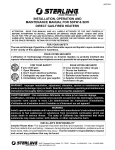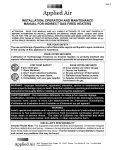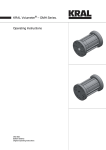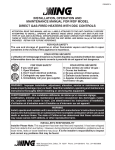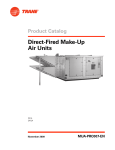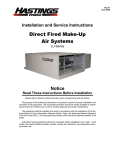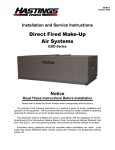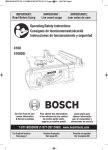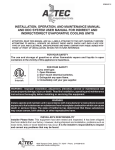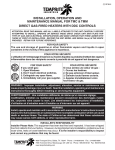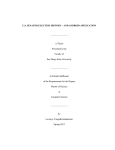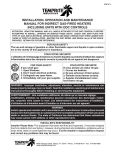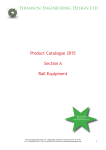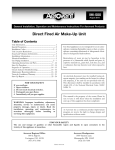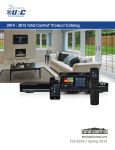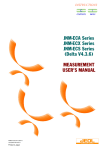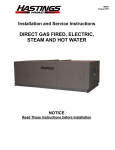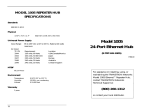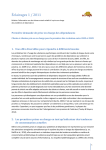Download installation, operation and maintenance manual for air curtains
Transcript
IOMKDFAC-1 INSTALLATION, OPERATION AND MAINTENANCE MANUAL FOR AIR CURTAINS FOR YOUR SAFETY The use and storage of gasoline or other flammable vapors and liquids in open containers in the vicinity of this appliance is hazardous. POUR VOTRE SÉCURITÉ L'utilisation et l'entreposage d'essence ou d'autres liquides ou produits émettant des vapeurs inflammables dans des récipients ouverts à proximité de cet appareil est dangereux. FOR YOUR SAFETY If you smell gas: 1. Open Windows 2. Don t touch electrical switches. 3. Extinguish any open flame. 4. Immediately call your gas supplier. c POUR VOTRE SÉCURITÉ Si vous sentez une odeur de gaz : 1. Ouvrez les fenêtres. 2. Ne pas actionner d'interrupteur. 3. Éteindre toute flamme ouverte. 4. Appelez immédiatement votre fournisseur de gaz. WARNING: Improper installation, adjustment, alteration, service or maintenance can cause property damage, injury or death. Read the installation, operating and maintenance instructions thoroughly before installing or servicing this equipment. AVERTISSEMENT : Une installation déficiente, de même qu'un mauvais réglage, modification, entretien ou maintenance peuvent occasionner des dommages matériels, corporels voire causer la mort. Lire attentivement les instructions d'installation, d'utilisation et d'entretien avant d'installer ou d'intervenir sur cet appareil. WARNING Install, operate and maintain unit in accordance with manufacturer's instructions to avoid exposure to fuel substances or substances from incomplete combustion which can cause death or serious illness. The state of California has determined that these substances may cause cancer, birth defects, or other reproductive harm. INSTALLER'S RESPONSIBILITY Installer Please Note: This equipment has been test fired and inspected. It has been shipped free from defects from our factory. However, during shipment and installation, problems such as loose wires, leaks or loose fasteners may occur. It is the installer's responsibility to inspect and correct any problems that may be found. 4830 Transport Drive, Dallas, TX 75247 Phone: 214-638-6010 Fax: 214-905-0806 SECTION I - FORWARD Table of Contents Section I: Forward and Table of Contents................... 2 Section II: General Information ................................... 2 Section III: Installation ................................................. 3 Section IV: Pre-Start Up .............................................. 6 Section V: Unit Start Up ..............................................7 Section VI: Unit Shut Down ......................................... 9 Section VII: Troubleshooting Guide .......................... 10 Section VIII: Maintenance Schedule and Lubrication Requirements ..................... 29 Section IX: Maxitrol Valve Adjustments and Preliminary Circuit Analysis ............. 36 Section X: Replacement Parts .................................. 39 Section XI: Recirculation ........................................... 39 As is the case with any fine piece of equipment, care must be taken to provide the proper attention to the operation and maintenance details of this machine. This manual of instructions has been prepared in order for you to become well-acquainted with those details, and in doing so, you will be able to give your Direct Gas-Fired System the care and attention which any piece of equipment needs and deserves. SECTION II - GENERAL INFORMATION A. Purpose The purpose of this manual is to present a guide for proper installation, maintenance, and operation of the Direct Gas-Fired System, and supplement, but not to replace, the services of qualified field service personnel to supervise the initial start-up and adjustment of the unit. Persons without previous experience with large commercial and industrial heating equipment should not attempt the initial adjustment and checkout procedure which is essential before such installations may be considered ready for operation. This manual should be made readily available to all operating personnel as an aid in troubleshooting and proper maintenance. Shipments are made F.O.B. Dallas, Texas by flatbed truck. The unit is securely strapped, tied, and blocked to prevent shipping damage. All shipments are checked by an inspector before they are accepted by the carrier. Parts that are shipped unmounted are noted on the bill of lading. These parts, where feasible, are packaged and shipped with the units. Upon receipt of shipment, all units should be checked against the bill of lading to insure all items have been received. All equipment (and any optional accessories) should be checked carefully for physical damage in the presence of the carrier s representative. If parts are missing or damage has occurred, a claim should be filed immediately with the carrier. B. Shipping Base Direct Gas-Fired units are shipped completely assembled where shipping limitations allow. Optional inlet hoods, filter and/or damper sections, or other large accessories are assembled and shipped mounted and wired whenever possible within limitations of shipping and handling. Any optional accessories shipped separately are shipped as assembled sections. Any wired accessories which have been disassembled for separate shipment require no additional conduit or wire for field reassembly. All wire leads will be tagged for ease of reconnection in the field. All Direct Gas-Fired units are given a complete operations test and control circuit checkout before shipment. Copies of the wiring diagram, piping diagram and bill of material are included with each unit shipped. If correspondence with the factory is necessary, please provide the unit model and serial number. C. Optional Factory Service Periodic service on any piece of mechanical equipment is necessary for efficient operation. A nationwide service support network is available to provide quick and dependable servicing of make-up air, heating, ventilating, or air handling types of equipment. Factory start-up service is also available which includes the presence of a service engineer to supervise the initial start-up and adjustment of the equipment and provide instructions for the owner s maintenance personnel in proper operations and maintenance. Consult factory for quotations on start-up or periodic service. 2 SECTION III - INSTALLATION Open the cover on the electrical control box located on the unit. Inspect all wire terminals and wiring terminations to ensure that all connections are tight. FOR CANADIAN INSTALLATIONS ONLY 1. All installations must conform with local building codes, or, in the absence of local codes, with current CAN/CGA-B149-Installation Codes For Gas Burning Appliances and Equipment. If units are not set immediately, cover all openings that might be exposed to the weather. 2. All electrical connections must be in accordance with Canadian Electrical Code, Part 1, CSA Standard C22.1. Rotate fans monthly. B. Locating the Unit Prior to locating the unit, authorities having jurisdiction should be consulted before installations are made. Approval permits should be checked against the unit received. This equipment must be installed and wired in accordance with regulations of the National Board of Fire Underwriters, National Electrical Code, and local governing bodies. The following recommendations are not intended to supplant any requirements of federal, state, or local codes having jurisdiction. Authorities having jurisdiction should be consulted before installations are made. Local codes may require additional safety controls and/or interlocks. If in doubt regarding the application of this appliance, consult the factory. Locate the unit exactly level. Special attention should be given to the duct, electrical, and fuel connection points. Install duct work with adequate flexible connections to isolate vibration from the duct work. All duct work should have taped or caulked seams. Duct work should be properly sized so as not to inhibit airflow. This information should be cross-checked with the position of support beams and stand pipes to insure that clearance dimensions coincide with those of the unit. The minimum clearance to combustible material must be maintained as listed in Table 1. All installations in airplane hangers must be in accordance with current ANSI/NFPA No. 409. All installations in public garages must be in accordance with current NFPA No. 88A and NFPA No. 88B. CAUTION: Do not install heating system in corrosive or flammable atmospheres! Premature failure of, or severe damage to the unit will result! CAUTION: Heating system must not be installed in locations where air for combustion would contain chlorinated, halogenated or acidic vapors. If located in such an environment, premature failure of the unit will occur! Table 1 Minimum clearance to combustible material, also consult local codes and regulations. Clearances to Combustible Material Vertical Units Horizontal Units Front* 39 inches 39 inches Rear 6 inches 6 inches Right 6 inches 6 inches Left 6 inches 6 inches Top 12 inches 12 inches Floor Zero 6 inches *Consider control side as front of unit. **Optimum clearance for shaft removal would be equivalent to cabinet width. A. Handling the Equipment The Direct Gas-Fired unit has been designed for rigging and handling through the use of special lifting lugs installed on the sides of each unit. As explained previously, the basic unit is designed for shipping in one piece where shipping limitations allow. Some optional accessories may require field mounting. When unloading and setting the unit, use the lifting lugs provided or move the equipment on rollers. Hooks, jacks, or chains must not be used around the casing, main control panel or exterior mounted controls. Make a visual inspection to insure no damage has occured to the unit during installation. During transit, unloading and setting of the unit, bolts and nuts may have become loosened, particularly in the pillow block ball bearing assemblies in the fan section. It is recommended that all nuts and set screws be tightened. Turn fan shaft by hand to make certain that blower does not rub against blower housing, and that bearing set screws are tight. If units are not set immediately, cover all openings that might be exposed to the weather. 3 E. Electrical Connections C. Curb Mounted Units Outdoor units can be supplied with an optional roof curb. The curb greatly facilitates installation thereby reducing installation costs. All connections to the unit: duct, piping, electrical power and control wiring can be made through the roof opening. The curb may be shipped prior to unit shipment. All curbs are shipped un-assembled from the factory. WARNING: Open all disconnect switches and secure in that position before wiring unit. Failure to do so may result in personal injury or death from electrical shock. WARNING: Controls must be protected from water. Do not allow water to drip on the ignition system. Use extreme caution in handling the curb. Proper handling and positioning will assure a water-tight curb unit installation. NOTE: Before installing any wiring, check the unit rating plate for supply power rating. Re-check approval prints prior to installation. Be sure that there are no obstructions to ducting and that proper planning has been exercised in connection of piping and/or electrical services. All electrical connections must conform to the current edition of: ANSI/NFPA No. 70 National Electrical Code and applicable state and local codes; in Canada, to the Canadian Electrical Code, Part 1 CSA Standard C22.1 and applicable provincial and local codes. The curb assembly may be bolted or welded to either trusses or roof decking; however, connection to roof trusses is recommended. The curb is designed to carry the weight of the unit. Additional support is required for certain applications. Since shipment of unit may require disassembly after factory check and test, reconnection of some electrical devices will be required in the field. Connect electrical wires (supplied in factory furnished conduit) to appropriate terminals. All leads are tagged to facilitate field connections. See wiring diagram provided with equipment. Complete all wiring to any optional accessories as shown on unit bill of material and electrical wiring diagram as required before applying voltage to the unit. Placement of the curb is critical in squareness and leveling. Shims for leveling must be applied to the curb; application of shims to the unit will tend to destroy the sealing effect after installation. Make sure sealing tape is in place before unit is set. Be careful not to allow gaps where two pieces of sealing tape meet. A bubble level must be used in the leveling process. Measure across diagonals to check for squareness. Allowable tolerance is 1/4" difference between diagonal measurements. Double-check approval prints before setting the unit. Entry location for all field-installed and control wiring is through the control panel. If optional disconnect is not furnished with heater, the field provided disconnect must be of the proper size and voltage. Refer to unit nameplate for minimum circuit ampacity and voltage. The disconnect must be installed in accordance with Article 430 of the current edition of ANSI/NFPA No. 70 National Electrical Code. Check the supply voltage before energizing the unit. The maximum voltage variation should not exceed 10%. Phase voltage unbalance must not exceed 2%. Upon completion of setting the curb, apply roofing material and flashing as required. D. Location of Accessories Where applicable, standard or optional accessories will be placed inside the fan section of the unit for shipment, and must be removed and installed by the mechanical or electrical contractor. Remotely located discharge or inlet dampers must be equipped with an end switch and interlocked to insure maximum design opening before starting and running circuits may be energized. NOTE: Should any original wire supplied with the heater have to be replaced, it must be replaced with wiring material having a temperature rating of at least 105 C. REMARQUE : Dans le cas où un quelconque des câbles livrés avec l'unité devait être remplacé, il doit être remplacé avec des câbles prévus pour résister à une chaleur d'au moins 105 C. Field constructed intake accessories should be properly designed to minimize the entry of rain and snow. Adequate building relief must be provided, so as to not over-pressurize the building, when the heater is operating at its rated capacity. This can be accomplished by taking into account, through standard engineering methods, the structure s designed infiltration rate, by providing properly sized relief openings, by interlocking a powered exhaust system, or by a combination of these methods. 4 Refer to the heater s rating plate for determining the maximum supply pressure to the heater. F. Field Piping All gas piping must be in accordance with the requirements outlined in the National Fuel Gas Code - ANSI Z223.1. It is required that a ground union be installed adjacent to the manifold for easy servicing. A drip leg and/or filter should be provided upstream of the unit s inlet gas connection. An additional shut-off must be located external of the unit s enclosure. The location of this valve must comply with all local codes. A 1/8 inch N.P.T. plugged tapping, accessible for test gauge connection, must be installed immediately upstream of the gas supply connection to the unit. Correctly sized piping must be run to the unit. Please note that gas line pressure must be as shown on specification plate when unit is operating at full input. G. Field Wiring and Remote Control Installation 1. Connect the power lines to the line side of the main disconnect switch. 2. Mount and wire remote control panel, thermostats, temperature sensors, and any other field installed controls as indicated on the unit control wiring diagram. 3. Connect the wires to the appropriate field wiring terminals as indicated on the unit control wiring diagram. 4. If the optional low temperature limit was not an integral part of the heater, the factory recommends that a low temperature limit control be installed in areas where freeze protection is needed in the event of burner shut down. 5. Field wiring shall have a temperature rating of at least 105C. The minimum size of the supply cable circuit shall be sufficient for the maximum ampacity of the heater. WARNING: To avoid equipment damage or possible personal injury, disconnect gas piping to this unit until a supply line pressure/leak test has been completed. Connecting the unit before completing the pressure/leak test may damage the unit gas valve and result in a fire hazard. DANGER: Never use an open flame to detect gas leaks. Explosive conditions may exist which would result in personal injury or death. The gas line should be supported so that no strain is placed on the unit. Pipe compounds which are not soluble to liquid petroleum gases should be used on threaded joints. L'installation éléctrique d'utilisateur aura une température qui évalue d'au moins 105C. La minimum de source du circuit de câblage sera suffisante pour le ampacity maximum de l'appareil de chauffage. Refer to the heater s rating plate for determining the minimum gas supply pressure for obtaining the maximum gas capacity for which this heater is specified. H. Locating Temperature Controls The room or outdoor thermostats should be mounted where they will not be subjected to direct impact of the heated air or radiant heat from the sun. It is also recommended that thermostats, especially those with mercury bulb contacts, be mounted on a vibration free surface. The side of building columns away from the heater or interior walls are usually the location best suited for mounting thermostats. Une tuyauterie adéquatement dimensionnée doit être posée jusqu'à l'unité. Veuillez noter que la pression de la tuyauterie d'alimentation en gaz doit correspondre à celle spécifiée sur la plaque d'identification, lorsque l'unité fonctionne à plein rendement. Controls with outdoor bulbs require that the outdoor bulb be shielded from direct radiation from the sun. Unit mounted sensors are factory located and mounted. 5 SECTION IV - PRE START-UP 6. Inspect pulleys and belts for tightness, tension and alignment. Do not overtighten belts. 7. Check set screws on all bearings, pulleys and fans for tightness. 8. Check voltage supplied to disconnect switch; the maximum voltage variation should not exceed 10%. Phase voltage unbalance must not exceed 2%. 9. Check thermostat(s) for normal operation. 10. Check that system duct work is installed and free from obstructions. 11. Check that fans turn free in housing. 12. Check that the area around the unit is clear of flammable vapors or containers of flammable liquids. 13. Check that all piping connections, particularly unions, are tight. 14. Check that all accessories requiring field wiring have been properly installed. 15. Check burner for proper location and alignment. 16. Check that filters and accessories are installed correctly. 17. Check that vent lines have been run to atmosphere on indoor units. Note that some units will use vent limiters and vent lines are not required. 18. Check that all manual gas shut-off valves are closed. 19. When failure or malfunction of this heater creates a hazard to other fuel burning equipment, (e.g. when the heater provides make-up air to a boiler room), the heater is to be interlocked to open inlet air dampers or other such devices. 20. Motor overload relay setting should match the motor s nameplate full load amperage. 21. Check that dampers and linkages are free to move, and that linkages are tight. 22. If inlet duct is attached to the heater, a purge timer must be provided and set to purge 4 times the inlet duct volume. A. Pre Start-Up The owners representative or equipment operator should be present during start-up to receive instructions on care and adjustments of the equipment. All equipment has been factory tested, adjusted, metered and inspected to meet conditions set at the time the order was placed. Only minimal adjustments should be required. All information in this service manual is typical. All products are semi-custom and changes may occur. Suggested Tools and Instruments Volt/Ohm Meter Thermometer Tachometer Ammeter Manometer (0-10" W.C.) Microammeter Standard Hand Tools D.C. Volt Meter Gas Pressure Gauge (0-35 lbs.) CAUTION: Line side of disconnect may be energized. Follow proper lockout/tagout procedures. NOTE: All servicing and adjustments of the Direct Gas-Fired unit should be performed by a qualified service engineer. This inspection is very important and should be completed with greatest care given to detail. A good pre-start inspection will insure against possible unit damage on start-up and will save valuable analysis time. 1. Check that the physical condition of the unit exterior is acceptable. 2. Check that the insulation inside of unit is properly secured. 3. Remove all shipping blocks, brackets and bolts from supply fan base with optional isolation base. 4. Check all wiring for loose connections and tighten if necessary. 5. Inspect all fan and motor bearings and lubricate if necessary. Purge time in seconds = 4 x L x W x H x 60 SCFM L = duct length in feet, W = duct width in feet, H = duct height in feet, SCFM = rating plate air throughput. Refer to the electrical schematic for the proper circuit placement. Purge timer P/N 65.0711.00. CAUTION: DO NOT RUPTURE GREASE SEALS. 6 SECTION V - UNIT START-UP GENERAL Unit Start-Up: Systems with Pilot Before attempting to start the heater read and understand the the sequence of operations and electrical schematic. Check the gas supply pressure by replacing the plug fitting on tthe pilot line with a pressure gauge having appropriate range, and opening the manual pilot valve. Check that the pressure reading is within the specified range on the nameplate. Make sure all doors and service panels have been closed or replaced. Turn main disconnect switch off. Check the incoming line voltage to match unit nameplate rating. If voltage is over 10% of nameplate rating or phase voltage unbalance is over 2%, notify contractor or power company. NOTE: To adjust gas pressure on supply lines where a regulator has been installed (to reduce the inlet pressure to name plate maximum pressure), remove dust cap of main gas regulator and turn adjusting screw clockwise to increase pressure or counter-clockwise to decrease pressure. Turn main disconnect switch on. Turn Fan-Off-On switch to On position. Damper opens (if applicable). Blower fan turns on. Connect test instrument to pilot flame test jack located on flame safeguard relay. Turn Fan-Off-On switch to Off position. Check supply blower for proper rotation. Set all thermostats to call for heat. Set inlet ductstat (if applicable) above outside air temperature. NOTE: To change rotation of the blower, simply interchange any two (2) of the line leads of the motor starter for three (3) phase motors. On single phase motors refer to motor nameplate. Open pilot and first main gas shut-off valves slowly. Last main gas shut-off valve before burner must remain closed at this time. Reset high-low gas pressure switches (if applicable). Check pilot and main gas lines for leaks using soap solution. Turn Fan-Off-On switch to On position. Check for proper blower rpm. Check that all motor amp draws do not exceed nameplate ratings and overloads are set to motor nameplate amps. Turn Fan and Heat-Off-On switches to On position. Blower fan will run. Check all dampers for proper operation, and linkage does not bind, see Sequence of Operation . Unit will run for 10 seconds before ignition trial, if all safety and limits are made. Make sure all manual gas valves are closed. NOTE: 3 OR 4 TRIALS MAY BE NEEDED TO PURGE AIR FROM PILOT LINE. IF BURNER HAS MAIN FLAME ROD OR SCANNER, YOU MAY NEED TO DISABLE TIMER CIRCUIT. Reset flame relay. Turn Fan and Heat Off-On switches to Off position. Honeywell Flame Safeguard Control Watch D.C. voltmeter carefully. The reading should be steady and between 2.0 to 5.0 volts D.C. If the reading is too low, slowly turn the needle valve in or out until satisfactory readings are obtained. A keyboard display module (Honeywell #S78000A1001) is recommended to read the flame signal, and is a good troubleshooting device. A V.O.M. can also be used on the DC voltage test jacks marked + and - on flame amplifier. On units with Signal Conditioner; the 0-10 VDC or 4-20 mA control signal (by others) must be applied to terminals #5 and #6 on the Signal Conditioner terminal strip. For 0-10 VDC control signal, place the three position DIP switch in the off position. For 4-20 mA control signal, place the three position DIP switch in the on position. The manufacturer recommends a temperature sensor to be placed in the unit discharge to limit the supply air temperature to 95 F or less. NOTE: Pilot regulator adjustment may be needed if the adjustment of the needle valve does not yield the required reading. When pilot is adjusted, shut the burner off by turning the Fan-Off-On and Heat-Off-On switches to Off. 7 Setting Main Flame Install manometer at test port on the last tee of the burner manifold, or MR valve test port. Open inlet manual gas shut-off valve slowly. Reset high and (if applicable) low gas pressure switches. Check main gas line for leaks using soap solution. Slowly open all manual gas shut-off valves. Unit will run for 5 seconds before ignition trial. Restart fan and burner. After pilot proven , main gas valve opens and burner lights. NOTE: 3 OR 4 TRIALS MAY BE NEEDED TO PURGE AIR FROM GAS LINE. Adjust high gas pressure reading (from manometer) to match firing rate shown on unit nameplate first. United Technologies Electronic Controls Spark Ignitor Watch microammeter carefully. Burner must hold in low fire for approximately 10 seconds before modulating up. The reading should be at least 0.5 microamps. If the reading is too low, slowly turn the low-fire adjustment on the modulating or two stage valve in or out until satisfactory readings are obtained. When adjusting low fire, there should be a continuous flame along the entire burner length without any blowout spots. Refer to Maxitrol Valve Adjustment instructions in Section IX for setting high and low fire gas pressure settings. On systems with pilot, the high fire setting must be made before adjusting low fire. Adjust the high fire setting according to the Maxitrol Valve Adjustment instructions in Section IX. The high fire setting must not exceed the pressure stated on the specification plate. Low fire must be adjusted first on units without pilot, and stay in low fire for approximately 10 seconds. When adjusting low fire, there should be a continuous flame along the entire burner length without any blowout spots. Main burner flame sensor must be activated, if applicable. Burner must hold in low fire for approximately 10 seconds before modulating up. Refer to Maxitrol Valve Adjustment instructions in Section IX for setting high and low fire gas pressure settings. When the flame is adjusted, shut the unit off by turning the Fan and Heat switches to OFF. Check pilot and main gas lines for leaks. Setting Main Flame Install manometer at test port on the last tee of the burner manifold or modulating valve. Main flame is now set. Make sure burner modulates and turn thermostat to the desired setting. Cycle pilot and burner a number of times to insure smooth light off. Slowly open all manual gas shut-off valves. Check flame signal with burner cycling through full firing range and burner profile damper operation (if applicable). Restart fan and burner. After main gas valves open and burner lights check gas lines for leaks. Unit Start-Up: Systems without Pilot Adjust high gas pressure reading (from manometer) to match firing rate shown on unit nameplate. Setting Burner Adjust the high fire setting according to the Maxitrol Valve Adjustment instructions in Section IX. The high fire setting must not exceed the pressure stated on the rating plate. When adjusting low fire, there should be a continuous flame along the entire length of the burner. NOTE: To adjust gas pressure on supply lines where a regulator has been installed (to reduce the inlet pressure to 1/2 PSIG or less), remove dust cap of main gas regulator and turn adjusting screw clockwise to increase pressure, or counter-clockwise to decrease pressure. Main flame is now set. Recheck the microamp signal on the ignition control throughout the full burner input range. Re-check low fire setting. Cycle unit 2 or 3 times to insure good ignition. Set all thermostats to call for heat. Set inlet ductstat (if applicable) above outside air temperature. Connect a DC microammeter between the SENSE terminal and the flame rod sensing wire. Turn Fan and Heat OFF/ON switches to ON position. 8 shut off the burner. Recycle is automatic when the sensing tube is replaced. When checking operation of air pressure switches on systems without pilot the heat switch will have to be turned off for approximately five seconds to reset the ignition control. Safety Controls Check All A. Flame Safeguard (piloted systems only) Close last manual gas valve before main burner. Operate unit in Heat mode. After pilot flame has been established, close manual pilot gas valve. The flame safeguard must trip out within 15 seconds. E. Adjustable temperature and limit Controls The limit controls are checked by adjusting control settings to a lower temperature setting while the unit is operating on high fire and observing cutoff. The controls should be reset to settings shown below: B. Ignition Control (pilotless system only) Operate unit in Heat mode. After flame has been established, close last manual gas valve before main burner. The ignition control must trip out within 15 seconds. Reset the ignition control by turning the HEAT switch to the OFF position. TC-01 RE-26 TC-03 RE-26 TC-08 TC-09 TC-52 C. Gas Pressure Switches The low pressure switch will trip out and must be reset before resuming operation when the inlet gas valve is turned off during operation. The high pressure switch may be checked out by reducing the setting of its trip point to unit operating pressure. It should then trip out and shut off the burner. Return the adjustment to its original setting and reset to resume operation. When checking operation of gas pressure switches on systems without pilot the heat switch will have to be turned off for approximately five seconds to reset the ignition control. PS-04 PS-07 PS-12 PS-13 FL-02 Suggested Control Settings Room Thermostat ........... Customer Discretion High Limit Discharge Ductstat .................. 95 F On-Off Inlet Ductstat ................................ 65 F Low Limit Discharge Ductstat ................... 55 F Freeze Thermostat (3 Min) ....................... 45 F Night Set Back Room ...... Customer Discretion Remote Temperature Selector ........................... Customer Discretion Low Gas Pressure Switch ................ 1.0" W.C. High Gas Pressure Switch ............. See Below Clogged Filter Switch .......... Adjust to field condition Building Pressure Switch .... Adjust to field condition High Temperature Limit (Manual) .................. 185 F D. Air Pressure Switches The high air pressure switch is checked by removing the sensing tube from the entering air side of the burner. Switch operation will shut off the burner. Recycle is automatic when the sensing tube is replaced. The low air pressure switch is checked by removing the sensing tube from the leaving air side of the burner. Switch operation will SECTION VI - UNIT SHUTDOWN A. Extended Shutdown 1. Set the Heat-On-Off switch to the Off position for 30 seconds, then turn the Fan-On-Off switch to Off position. 2. Close all manual gas valves. 3. Open the main electrical disconnect switch. B. Emergency Shutdown ONLY 1. Open the main electrical disconnect switch. 2. Close the main manual gas valve. 9 SECTION VII - TROUBLE SHOOTING HONEYWELL RM7895A,B,C,D/EC7895A,C; RM7896A,B,C,D 7800 SERIES RELAY MODULES 5. MAIN FLAME ESTABLISHING PERIOD (MFEP) (RM7895C,D/EC7895C; RM7896C,D) a. Airflow lockout feature is enabled and the airflow switch opens. b. Ignition terminal is energized. c. Ignition/pilot valve terminal is not energized. d. Main valve terminal is not energized. e. Delayed main valve terminal is energized. f. No flame present at end of MFEP. g. Internal system fault occurred. h. Purge card is removed. i. Purge card is bad. 6. RUN PERIOD a. No flame present. b. Airflow lockout feature is enabled and the airflow switch opens. c. Interrupted pilot valve terminal is energized (RM7895C,D/EC7895C; RM7896C,D). d. Main valve terminal is not energized. e. Delayed (second stage) main valve terminal is not energized (RM7895C,D/EC7895C; RM7896C,D). f. Internal system fault occurred. g. Purge card is removed. h. Purge card is bad. PRINCIPAL TECHNICAL FEATURES The RM7895, RM7896 provides all customary flame safeguard functions as well as significant advancements in safety, annunciation, and system diagnostics. Safety Shutdown (Lockout) Occurs if: 1. INITIATE PERIOD a. Purge card is not installed or removed. b. Purge card is bad. c. Configuration jumpers have been changed (after 200 hours). d. AC line power errors occurred, see Operation. e. Four minute INITIATE period has been exceeded. 2. STANDBY PERIOD a. Airflow lockout feature is enabled and the airflow switch does not close after ten seconds or within the specified purge card timing. b. Flame signal is detected after 30 seconds. c. Ignition/pilot valve/intermittent pilot valve terminal is energized. d. Main valve terminal is energized. e. Delayed (2nd stage) main valve terminal is energized (RM7895C,D/EC7895C; RM7896C, D). f. Internal system fault occurred. g. Purge card is removed. h. Purge card is bad. 3. PREPURGE PERIOD a. Airflow lockout feature is enabled and the airflow switch opens. b. Ignition/pilot valve terminal is not energized. c. No flame present at end of PFEP. d. Main valve terminal is energized. e. Delayed main valve terminal is energized (RM7895C,D). f. Internal system fault occurred. g. Purge card is removed. h. Purge card is bad. 4. PILOT FLAME ESTABLISHING PERIOD (PFEP) a. Airflow lockout feature is enabled and the airflow switch does not close after ten seconds or within the specified purge card timing. b. Flame signal is detected after 30 seconds. c. Ignition/pilot valve/intermittent pilot valve terminal is energized. d. Main valve terminal is energized. e. Delayed (second stage) main valve terminal is energized (RM7895C,D/EC7895C; RM7896C,D). f. Internal system fault occurred. g. Purge card is removed. h. Purge card is bad. OPERATION Sequence of Operation The RM7895A,B,C,D/EC7895A,C; RM7896A,B,C,D has the operating sequences listed below; see Fig. 2 and 3. The RM7895A,B,C,D/EC7895A,C; RM7896A,B,C,D LED provide positive visual indication of the program sequence: POWER, PILOT, FLAME, MAIN and ALARM. Initiate The RM7895A,B,C,D/EC7895A,B,C; RM7896A,B,C,D Relay Module enters the INITIATE sequence when the relay module is powered. The RM7895A,B,C,D/ EC7895A,C; RM7896A,B,C,D can also enter the INITIATE sequence if the relay module verifies voltage fluctuations of +10/-15% or frequency fluctuations of 10% during any part of the operating sequence. The INITIATE sequence lasts for ten seconds unless the voltage or frequency tolerances are not met. When not met, a hold condition is initiated and displayed on the optional KDM for at least five seconds; when met, the INITIATE sequence restarts. If the condition is not corrected and the hold condition exists for four minutes, the RM7895A,B,C,D/EC7895A,C; RM7896A,B,C,D locks out. 10 SECTION VII - TROUBLE SHOOTING 2. `Main Flame Establishing Period (MFEP): a. After Ignition Trials, and with the presence of flame, the main fuel valve, terminal 9, is powered. If a flameout occurs, the relay module locks out or recycles (depending on status of jumper JR2) within 0.8 or 3 seconds, depending on the Flame Failure Response Time (FFRT) of the amplifier. b. The RM7895C,D/EC7895C, and RM7896C,D have a ten second MFEP. After the Ignition Trials and with the presence of flame, the main fuel valve, terminal 9, is powered. If a flameout occurs, the relay module locks out within 0.8 or 3 seconds, depending on the amplifier FFRT. Causes for hold conditions in the INITIATE sequence: 1. AC line dropout detection. 2. AC line noise that can prevent a sufficient reading of the line voltage inputs. 3. Low line voltage brownouts. The INITIATE sequence also delays the burner motor starter from being energized and de-energized from an intermittent AC line input or control input. Standby The RM7895A,B,C,D/EC7895A,C; RM7896A,B,C,D is ready to start an operating sequence when the operating control input determines a call for heat is present. The burner switch, limits, operating limit control and all microcomputer-monitored circuits must be in the correct state for the relay module to continue into the PREPURGE sequence. Run 1. The RM7895C,D, EC7895C, RM7896C,D has a delayed main valve that is energized once the RUN period is entered. 2. The relay module is now in RUN and remains in RUN until the controller input, terminal 6, opens, indicating that the demand is satisfied or a limit has opened. Normal Start-Up Prepurge The RM7895A,B,C,D/EC7895A,C; RM7896A,B,C,D Relay Module provides PREPURGE timing selectable from two seconds to thirty minutes with power applied and the operating control indicating a call for heat. 1. The Airflow Interlock, burner switch, Run/Test switch and all microcomputer-monitored circuits must also be in the correct operating state. 2. The motor output, terminal 4, is powered to start the PREPURGE sequence. 3. The Airflow Interlock input closes ten seconds into PREPURGE or within the specified purge card timing; otherwise, a recycle to the beginning of PREPURGE or lockout occurs, depending on how the Airflow Switch selectable jumper (JR3) is configured. Post Purge (RM7896A,B,C,D Only) After demand is satisfied or a limit opens, de-energizing terminal 6, the Ignition/Pilot valve, main valve and delayed main valve, terminals 8, 9 and 21, are de-energized. The blower motor, terminal 4, remains powered for 15 seconds. Run/Test Switch (RM7895C,D/EC7895C; RM7896C,D only) The Run/Test Switch is located on the top side of the relay module, see Fig. 5. The Run/Test Switch allows the burner sequence to be altered as follows: 1. In the measured PREPURGE sequence, the Run/ Test Switch, placed in the TEST position, causes the PREPURGE timing to stop. 2. In the Pilot Flame Establishing Period, the Run/ Test Switch, placed in the TEST position, stops the timer during the first eight seconds of a ten-second PFEP selection or during the first three seconds of a four-second PFEP selection. It also allows for pilot turn-down test and other burner adjustments. This activates a fifteen-second flameout timer that permits pilot flame adjustment without nuisance safety shutdowns. The Run/Test Switch is ignored during PFEP for the C and D relay modules if terminals 8 and 9 or 9 and 21 are jumpered. Ignition Trials 1. Pilot Flame Establishing Period (PFEP): a. When the PFEP begins: (1) The pilot valve and ignition transformer, terminals 8 and 10, are energized. The RM7895A,B, EC7895A, and RM7896A,B have an intermittent pilot valve, terminal 8. The EC7895C, RM7895C,D, and RM7896C,D have an interrupted pilot valve, terminal 8. (2) Flame must be proven by the end of the ten second PFEP (four seconds if Configuration Jumper JR1 is clipped) to allow the sequence to continue. If a flame is not proven by the end of PFEP, a safety shutdown occurs. b. With flame proven, the ignition, terminal 10, is de-energized. IMPORTANT: When the relay module is switched to the TEST mode, it stops and holds at the next Run/ Test Switch point in the operating sequence. Make sure that the Run/Test Switch is in the RUN position before leaving the installation. 11 SECTION VII - TROUBLE SHOOTING Figure 6 - Selectable Site-Configurable Jumpers SETTINGS AND ADJUSTMENTS Selectable Site-Configurable Jumpers The relay module has three site-configurable jumper options, see Fig. 6 and Table 7. If necessary, clip the site-configurable jumpers with side cutters and remove the resistors from the relay module. SELECTABLE CONFIGURATION JUMPERS RUN/TEST SWITCH (EC7895C; RM7895C,D; RM7896C,D) SERVICE NOTE: Clipping and removing a siteconfigurable jumper enhances the level of safety. Figure 5 - Sequence Status LEDs RUN/TEST SWITCH (RM7895C,D; EC7895C; RM7896C,D) CAPTIVE MOUNTING SCREW PLUG-IN PURGE CARD M7553A DUST COVER SEQUENCE STATUS LEDs Table 7 - Site-Configurable Jumper Options RELAY MODULE RESET PUSHBUTTON Jumper Number FLAME AMPLIFIER FLAME SIMULATOR INPUT JR1* Seconds FLAME CURRENT TEST JACKS M7552A Description Intact Pilot Flame Establishing Period (PFEP) JR2 Flame Failure Action JR3 Airflow Switch (ILK) Failure Clipped 10 Seconds Recycle Recycle 4 Lockout Lockout IMPORTANT: Clipping and removing a jumper after 200 hours of operation causes a nonresettable Fault 110. The relay module must then be replaced. WIRING SUBBASE RUN/TEST (C,D ONLY) SWITCH RELAY MODULE CONFIGURATION JUMPERS PURGE TIMER SEQUENCE STATUS LED PANEL RESET BUTTON CAPTIVE MOUNTING SCREW DUST COVER FLAME AMPLIFIER M15122 Figure 4 - RM7895A,B,C,D/EC7895A,C; RM7896A,B,C,D Relay Module Exploded View 12 SECTION VII - TROUBLE SHOOTING Figure 2 - Wiring Subbase and Sequence Chart for RM7895A,B/EC7895A; RM7896A,B Q7800 FOR DIRECT SPARK IGNITION (OIL OR GAS) G 12 L2 13 10 IGNITION TRANSFORMER LINE VOLTAGE ALARM 3 14 8 MAIN VALVE BURNER MOTOR (BLOWER) 4 15 L2 5 (L1) 16 BURNER CONTROLLER/LIMITS 6 17 LOCKOUT INTERLOCK (INCLUDING AIRFLOW SWITCH) 7 18 INTERMITTENT PILOT/IGNITION 8 19 MAIN FUEL VALVE(S) 9 20 10 21 F 22 2 IGNITION FLAME DETECTOR 4 L1 (HOT) 3 L2 00 LED DISPLAY MASTER SWITCH INITIATE POWER STANDBY POWER 00 START POWER 00 TIMED PURGE PFEP 4 OR 10 SEC 7 POST PURGE 15 SEC RUN POWER POWER POWER PILOT PILOT PILOT FLAME FLAME FLAME MAIN MAIN MAIN ALARM ALARM 10 IGN 4 POWER 7 8 MAIN VALVE FLAME SIGNAL STANDBY 5 IGN/ PILOT OPERATING CONTROLS AND INTERLOCKS POWER ALARM BURNER/BLOWER MOTOR BURNER START 1 9 LIMITS AND BURNER CONTROLLER CLOSED L1 TO 6 6 AIRFLOW SW CHECK LOCKOUT INTERLOCK CLOSED 6 TO 7 FLAME PROVING SAFE START CHECK 1 RM7895, RM7896: 120 VAC , 50/60 HZ; EC7895: 220-240 VAC, 50/60 HZ POWER SUPPLY. PROVIDE DISCONNECT MEANS AND OVERLOAD PROTECTION AS REQUIRED. AFSC SSC 4 SEE FLAME DETECTOR SPECIFICATIONS FOR CORRECT WIRING. 5 FOR RM7895A1048 (ONLY), IGNITION TERMINAL 10 IS DE-ENERGIZED WHEN FLAME IS PROVEN. 2 DO NOT CONNECT ANY WIRES TO UNUSED TERMINALS. 3 FOR EC7895, A 220 TO 240 VAC TO 120 VAC, 10 VA MINIMUM STEPDOWN TRANSFORMER (NOT PROVIDED) MUST BE USED TO DRIVE THE SHUTTER. 6 AIRFLOW SWITCH CHECK FEATURE IS FOR THE RM7895B,RM7896B. 13 7 RM7896A,B ONLY. M15123A SECTION VII - TROUBLE SHOOTING Figure 3 - Wiring Subbase and Sequence Chart for RM7895C,D/EC7895C,D; RM7896C,D Q7800 FOR DIRECT SPARK IGNITION (OIL OR GAS) G 12 L2 13 10 LINE VOLTAGE ALARM 3 14 8 BURNER MOTOR (BLOWER) 4 15 5 (L1) IGNITION TRANSFORMER L2 9 MAIN VALVE 16 BURNER CONTROLLER/LIMITS 6 17 LOCKOUT INTERLOCK (INCLUDING AIRFLOW SWITCH). 7 18 10 SEC. INTERRUPTED PILOT/IGNITION 8 19 MAIN FUEL VALVE(S) 9 20 IGNITION 10 21 F 22 2 FLAME DETECTOR DELAYED (2ND STAGE) MAIN VALVE MASTER 1 SWITCH L1 (HOT) 4 3 L2 00 LED DISPLAY INITIATE POWER STANDBY POWER 00 START POWER 1 6 00 PFEP 7 4 OR 10 SEC MFEP TIMED PURGE RUN POST PURGE 15SEC POWER POWER POWER POWER POWER PILOT PILOT PILOT PILOT FLAME FLAME FLAME FLAME MAIN MAIN MAIN MAIN ALARM ALARM ALARM ALARM BURNER/BLOWER MOTOR BURNER START IGN. 10 4 STANDBY POWER 6 8 10 SEC. IGN./ PILOT 8 MAIN VALVE 9 2ND STAGE MAIN 21 OPERATING CONTROLS AND INTERLOCKS FLAME SIGNAL LIMITS AND BURNER CONTROLLER CLOSED 5 AIRFLOW SW. CHECK LOCKOUT INTERLOCK CLOSED L1 TO 6 6 TO 7 AFSC SSC FLAME PROVING SAFE START CHECK 1 RM7895, RM7896: 120 VAC , 50/60 HZ; EC7895: 220-240 VAC, 50/60 HZ POWER SUPPLY. PROVIDE DISCONNECT MEANS AND OVERLOAD PROTECTION AS REQUIRED. 4 SEE FLAME DETECTOR SPECIFICATIONS FOR CORRECT WIRING. 2 DO NOT CONNECT ANY WIRES TO UNUSED TERMINALS. 6 RM7896C,D ONLY. 3 FOR EC7895, A 220 TO 240 VAC TO 120 VAC, 10 VA MINIMUM STEPDOWN TRANSFORMER (NOT PROVIDED) MUST BE USED TO DRIVE THE SHUTTER. 7 5 AIRFLOW SWITCH CHECK FEATURE IS FOR THE RM7895D, RM7896D. RM7895C1020, RM7896C1036 PFEP 10 SECONDS ONLY. 8 RM7895C1020, RM7896C1036: DURING FIRST 8 SECONDS OF PFEP, WHEN A FLAME SIGNAL IS DETECTED, TERMINAL 10 IS DE-ENERGIZED. IF FLAME SIGNAL IS LOST, TERMINAL 10 WILL RE-ENERGIZE. M15124GR 14 SECTION VII - TROUBLE SHOOTING 4. With main burner operating, check the gas control flow rate using the meter clocking method or check pressure using a manometer connected to the outlet pressure tap on the gas control. 5. If necessary, adjust the high pressure regulator to match the appliance rating. a. Remove the pressure regulator adjustment cap. b. Using a screwdriver, turn the inner adjustment screw for HI pressure clockwise to increase or counterclockwise to decrease the gas pressure to the burner. 6. After high pressure has been checked, check low pressure regulation. Two-stage appliance operating sequences vary. Consult the appliance manufacturers instructions for the specific operating sequence and regulator adjustment procedure for the appliance in which the control is installed and for instructions on how to prevent the control from moving to high stage while checking the low pressure regulator setting. 7. Check the low rate manifold pressure listed on the appliance nameplate. Gas control low rate outlet pressure should match this rating. 8. With main burner operating, check the gas control flow rate as before (using the meter clocking method or check pressure using a manometer connected to the outlet pressure tap on the control). 9. If necessary, adjust the low pressure regulator to match the appliance rating. a. Remove the pressure regulator adjustment cap. b. Using a screwdriver, turn the inner adjustment screw for LO pressure clockwise to increase or counterclockwise to decrease the gas pressure to the burner. 10. Once high and low pressure have been checked and adjusted, replace pressure regulator adjustment cap. If the desired outlet pressure regulator or flow rate cannot be achieved by adjusting the gas control, check the control inlet pressure using a manometer at the inlet pressure tap of the control.Take the necessary steps to provide proper gas pressure to the control. United Technologies Electronics Controls Operation of the Series 1016-400 Direct Spark Ignition Control On a call for heat a five second pre-purge is initiated. Upon completion of the pre-purge, the gas valve and 60 Hz spark are energized. When flame is detected, the control enters the steady state heating condition. Steady state heating will continue until the call for heat is satisfied. If ignition is not achieved within 10 seconds, the control shuts off the gas and locks out. If the trial for ignition has been accomplished without ignition, the control shuts off all outputs and enters lockout. Reset is accomplished by cycling the power off for a minimum of 5 seconds. If flame is lost once it has been established, the control will shut off the gas valve within 0.8 seconds and locks out. If flame is sensed during a purge period when no flame should be present, the control will remain in purge with the gas valve off until the false flame disappears. If the gas valve is found to be powered when it should be off, or not powered when it should be on, the control will enter lockout with all outputs off. Reset is accomplished by cycling the power off for a minimum of 5 seconds. Honeywell Two Stage Valve Two-stage models require that you check and adjust both high and low pressure regulator settings. Twostage appliance operating sequences vary. Consult the appliance manufacturer instructions for the specific operating sequence and regulator adjustment procedure for the appliance in which the control is installed. 1. Set appliance to operate on high. 2. Carefully check the main burner lightoff. Make sure that the main burner lights smoothly and that all ports remain lit. 3. Check the full rate (high) manifold pressure listed on the appliance nameplate for high pressure. The gas control full rate outlet pressure should match this rating. 15 SECTION VII - TROUBLE SHOOTING 6. Set the thermostat below room temperature and wait one minute. 7. Operate system through one complete cycle to make sure all controls operate properly. Check Safety Shutdown Performace WARNING: Fire or explosion hazard. Can cause property damage, severe injury or death. Perform the safety shutdown test any time work is done on a gas system. This equpipment has been electrically and fire tested prior to shipment. However, during transit control setpoints can change, and wiring can come loose. Do not assume controls are defective until all associated setpoints and wiring are checked. NOTE: Read steps 1 through 7 before starting, and compare to the safety sutdown or safety lockout tests recommended for the intermittent pilot (IP) ignition module. Where diffferent, use the procedure recommended for the module. The following is a simplified list of possible problems and typical causes and remedies. However, it does not cover all possibilities, and is intended as a guide only. You might also need to reference the AdaptAire Digital Control System User Manual as a troubleshooting guide for DDC system. 1. Turn off gas supply. 2. Set thermostat or controller above room temperature to call for heat. 3. Watch for ignition spark or for glow at hot surface igniter either immediately or following prepurge. See IP module specifications. 4. Time the length of the spark operation. See the IP module specifications. 5. After the module locks out, open the manual gas cock and make sure no gas is flowing to the pilot or main burner. WARNING: Many of the steps listed below require electrical cabinet and blower access while the unit is powered. High voltage and moving parts are present, and these steps should be performed by qualified service personnel. If any of the controls requiring manual reset were at fault this is an indication of a problem with the system that should be investigated. 16 SECTION VII - TROUBLESHOOTING System with Pilot Symptom A. If blower does not operate. Cause Remedy 1. Low or no voltage. 2. Fuse(s) blown. 3. Customer interlock not closed or connected. 4. Fan Off-On switch in Off position. 5. Time clock, night setback thermostat, or field installed controls open. 6. Freeze protection tripped. 7. Damper motor not operating, or its end switch not making. 8. Overload Protection on motor starter tripped. 9. Belts loose or broken. 10. Bearings seized. 11. Motor may be burned or incorrectly wired. 12. Motor overheating. B. If there is no voltage at flame safeguard relay input terminal. 1. Heat-Off-On switch in Off position. 2. Auxiliary switch on starter not closed. 3. Air flow switches open. 4. Outside air temperature higher than on-off inlet ductstat setting (if applicable). 5. High temperature limit thermostat open. 6. High-low gas pressure switch open. (If applicable) 7. Field purge timer open. (If applicable) 1. Check power source. 2. Check and replace. 3. Close or connect customer interlock. 4. Switch to On position. 5. Check time clock, night setback thermostat and field installed controls for proper settings. 6. Reset freeze stat by interrupting power. Check for proper setting and burner operation. 7. Check for power at damper motor and that end switch has been wired correctly to the N.O. (normally open) contact. Check that the linkage is clear and not binding. 8. Push reset button on starter and check amps. 9. Turn power off and check belts. 10. Check and replace. 11. Turn power off and check motor and wiring. 12. Check burner firing rate. 1. Switch to On position. 2. Check auxiliary circuit wiring and contact. 3. Adjust the air flow and external static pressure to match the rating plate. 4. Check stat for proper setting. 5. Reset control and correct problem before restarting. 6. Check gas pressure and reset switch. 7. Check for power or replace if necessary. C. If the flame safeguard relay goes into saftety shutdown (lockout). 1. See technical cut sheet on flame safeguard relay. 1. Determine the cause of (lockout). Push reset button on flame safeguard relay. D. If pilot does not light after prepurge has timed out (10 seconds) and voltage is present on flame safeguard output terminals. 1. Manual pilot shut-off valve closed. 2. Inlet gas pressure lower than required gas pressure 3. No gas through pilot regulator with inlet gas pressure ok. 4. No gas through pilot solenoid. 1. Slowly open valve. 2. Increase gas pressure. 17 3. Clear obstruction in vent orifice/ line or replace if defective. 4. Check for correct installation and voltage. Correct or replace. SECTION VII - TROUBLESHOOTING System with Pilot Symptom D. Cause Remedy 5. Type of gas (natural - LP) supplied different from factory required type. Note: components may change. 6. Flame detection system not sensing pilot flame.(see spark rod diagram #P-001003) 7. No voltage on secondary side of ignition transformer. E. If pilot does not light after prepurge has timed out and there is no voltage at flame safeguard relay output terminals. 1. Flame safeguard relay Run/Test switch in Test position or functioning problem. F. If there is no heat with pilot ok and voltage is present at flame safeguard relay output terminals. 1. Manual gas shut-off valve closed. 2. No gas on outlet side of regualtors with inlet pressure ok. 3. No gas on outlet side of valve or actuator with inlet pressure ok. 4. Main flame rod or scanner not sensing main burner. G. If there is no heat with pilot ok and no voltage is present at flame safeguard relay output terminals. 1. Flame safeguard relay Run/Test switch in Test position or fucntioning problem. 18 5. Replace with factory required type of gas. 6a. UV Sensor - clean lens and sight tube and check wiring and spark plug. 6b. Flame Rod - assure rod is in flame, check wiring and flame rod. 7. Check wiring or replace transformer if correct. 1. Place in run position (see technical cut sheet on flame safeguard relay). 1. Turn Heat-Off-On switch to Off position. Slowly open all manual gas shut-off valves before restarting. 2. Clear obstruction in vent orifice/ line or replace if defective. 3. Turn Heat-Off-On switch to On postion. After 10 seconds of prepurge, pilot will light. Then after 5 to 10 seconds main valve light will come on. Check to see if all gas valves have opened. If not, check voltage at gas valve. If voltage is found to be correct, replace gas valve or actuator (see Maxitrol troubleshooting Guide for modulating valve). 4a. Check burner for low fire adjustment. 4b. UV Sensor - clean lens and sight tube and check wiring. 4c. Flame Rod - be sure flame rod is in main flame, check wiring and flame rod. 1. Place in Run position (see technical cut sheet on flame safeguard relay). SECTION VII - TROUBLESHOOTING System with Pilot Symptom H. Burner will not respond to temperature. Cause Remedy 1. For Maxitrol System. 2. For RTC System. I. 75/25 or 50/50 return air/ outside air or discharge air/profile damper operation not functioning properly (see sequence of operation for damper control). J. Burner will not come on in low speed. 1. Defective photohelic switch. 2. Photohelic or null switch wired incorrectly. 3. Phothelic or null switch not installed correctly. 4. Temperature control defective. 5. Temperature control wired up incorrectly. 6. Temperature control bulb installed incorrectly. 7. Two position switch defective. 8. Damper motor and/or potentiometer defective. 9. Dampers binding and/or loose. 1. Low air flow switch open. 2. Profile damper not closing (if applicable). K. Flame length too long in low speed. 1. Incorrect setting or defective MP-05 in electrical panel. 2. Low speed high fire set incorrectly. 19 1. Refer to following troubleshooting guide for Maxitrol MDT or MRT controls. 2. Refer to following troubleshooting guide for RTC MDT controls. 1. Check and/or replace. 2. Check wiring. 3. Install correctly (see manufacturer s cut sheet). 4. Check and/or replace. 5. Check wiring. 6. Install bullb in correct location. 7. Check and or replace. 8. Check and or replace. 9. Check and repair. 1. Check to make sure velocity is correct. 2. Check and/or replace. 1. Check setting or replace. 2. Make normal maximum and minimum fire adjustments as outlined earlier. Open switch and/ or relay RE-52 and remove wire from terminal #4 on MDT system or terminals #2 & #4 on MRT system. Adjust MP-05 (located in electrical panel) for approximately one half of the firing rate. Reconnect wiring to amplier. TROUBLESHOOTING GUIDE System without Pilot Symptom A. If blower does not operate. Cause Remedy 1. Low or no voltage. 2. Fuse(s) blown. 3. Customer interlock not closed or connected. 4. Fan Off-On switch in Off position. 5. Time clock, night setback thermostat or field installed controls open. 6. Freeze protection tripped. 7. Damper motor not operating, or its end switch not making. 8. Overload protection on motor starter tripped. 9. Belts loose or broken 10. Bearings seized. 11. Motor may be burned or incorrectly wired. 12. Motor overheating. B. If there is no voltage at ignition control. C. Burner does not light after 5 seconds pre purge of flame safeguard relay and there is voltage at ignition control. 1. Check power source. 2. Check and replace. 3. Close or connect customer interlock. 4. Switch to On position. 5. Check time clock, night setback thermostat and field installed controls for proper settings. 6. Reset freeze stat by interrupting power. Check for proper setting and burner operation. 7. Check for power at damper motor and that end switch has been wired correctly to the N.O. (normally open) contact. Check that the linkage is clear and not binding. 8. Push reset button on starter and check amps. 9. Turn power off and check belts. 10. Check and replace. 11. Turn power off and check motor and wiring. 12. Check burner firing rate. 1. Heat Off-On switch in Off position. 2. Burner enable relay open (if applicable). 3. Outside air temperature higher than On-Off inlet ductstat (if applicable). 4. Field purge timer open (if applicable). 1. Switch to On position. 1. Manual gas shut-off valve closed. 2. Inlet gas pressure lower than required gas pressure. 3. Type of gas (Natural, LP) supplied different from factory required type. 4. Auxiliary switch on starter not closed. 5. Air flow switches not closing. 1. Slowly open valve. 2. Increase gas pressure. 6. High temperature limit switch open. 7. High or low gas pressure switches open (if applicable). 8. Main gas valve relay open. 20 2. Check for power and replace if necessary. 3. Lower On-Off inlet ductstat setting. 4. Check for power and replace if necessary. 3. Replace with factory required type of gas. 4. Check for power and replace if necessary. 5. Adjust the air flow and external static pressure to match rating plate. 6. Correct problem. Reset by pushing down the reset button. 7. Correct problem. Reset both switches. 8. Check for power and replace if necessary. TROUBLESHOOTING GUIDE System without Pilot Symptom C. Cause Remedy 9. Defective gas valve or actuator. 10. Defective spark rod or out of position. (see drawing #P-001004 or #P-00117) 11. Flame rod not sensing flame. (see drawing #P-001003 or #P-00117) 12. Defective regulator. 13. Blocked vent lines or vent limiters. 14. Low fire set too low or too high. D. Burner will not respond to temperature. 1. For Maxitrol system. 2. For RTC system. 3. For Honeywell system. 21 9. Check power to gas valves. If gas pressure matches unit rating plate and valve does not open, replace gas valve or actuator. 10. Make sure spark rod is producing a sufficient spark to light off burner, make sure porcelain is not cracked. Check wiring or replace if necessary. 11. Make sure flame rod is in flame. Make sure porcelain is not cracked. Check wiring or replace if necessary. 12. Clean or replace regulator. 13. Check vent lines or replace limiters. 14. Adjust setting on modulating valve or two stage gas valve. 1. See following troubleshooting guide for Maxitrol MDT or MRT controls. 2. See following troubleshooting guide for RTC MDT controls. 3. See following troubleshooting guide for Honeywell. TROUBLESHOOTING GUIDE The Direct Fired Control from RTC Solutions provides some diagnostics via the on board LED labeled POWER/ STATUS . A system fault is indicated by a fast blinking LED (about twice per second). This usually indicates that the sensor or dial are either disconnected or improperly wired. Check all connections per the included wiring diagrams. The fault also may be caused by a damaged sensor or dial. Both devices may be tested with an Ohmmeter by removing the wires from the Direct Fired Control and measuring across the device. The devices should measure between 12.8K and 7K OHMS. If there is a fault light and the devices measure the proper resistance then the control may be damaged. If there is no fault light but the system is not modulating properly you may check the control output by repeating the start up procedure and measuring the voltage across terminals 5 and 6 on the Direct Fired Control as follows: Remove the wire from terminal number 4 on the Direct Fired Control and measure the voltage across terminals 5 and 6 with a voltmeter. The meter should read from 20 to 24 volts. If it does not, disconnect the wires from the valve and measure the output without the valve connected. If it reads 20 to 24 volts refer to the valve manufacturer literature for troubleshooting the valve. If it does not the control may be damaged. Refer to following chart for other troubleshooting suggestions. Modulating Discharge Temperature (MDT) Controls Symptom Possible Cause Portions reproduced with permission from Maxitrol® Company Field Test Remedy A. No Gas Flow. 1. Modulating valve improperly installed. 1. Arrow on side of valve should point in direction of gas flow. 1. Install properly. B. Continuous Low Fire (Electronics Problem). 1. Short circuit or no voltage to the amplifier. 2. Open circuit in Remote Temperature Selector circuit or wiring. 1. Check for 24V AC at amplifier terminals 7 & 8. 2. Inspect for loose or broken wires between amplifier terminals 1 & 2 and Remote Temperature Selector terminals 1 & 3. 3. Connect test resistor as described in Preliminary Circuit Analysis in Section IX. Follow procedures outlined. 1. Prove the power source. 4. Faulty amplifier. 4. Check items B1-3. 4. If items B1-3 check out and modulating voltages are still not obtained, amplifier may be assumed faulty. Replace. 1. Short circuit or open circuit in Modulator Coil. 1. Measure resistance across modulator terminals with connecting wires detached. 2. Plunger missing, jammed or improperly installed. 2. Inspect. Plunger should be installed to operate freely in solenoid sleeve. 1. Replace modulator head if not approximately 45-55 ohms for M611 Valve and 60-80 ohms for MR212 Valve. 2. Clean or replace plunger if necessary. 3. Short circuit in Discharge Air Sensor circuit or wiring. C. Continuous Low Fire (Electronics OK). 22 2. Tighten connections or replace wiring. 3. If modulating voltages are obtained, check Discharge Air Sensor circuit for shorts. Replace if necessary. TROUBLESHOOTING GUIDE Modulating Discharge Temperature (MDT) Controls Portions reproduced with permission from Maxitrol® Company Symptom Possible Cause D. Incorrect Minimum Fire Erratic or Pulsating Flame. 1. Incorrect by-pass metering valve adjustment. 2. Excessive negative burner pressure. 1. See valve adjustments in Section IX. 1. Adjust to proper minimum fire. 2. Close main gas supply and measure manifold pressure with blower operating. Reading should be less than 1.5" w.c. negative pressure. 2. If reading is greater than 1.5" negative pressure, check for clogged filters or other inlet air restrictions. Consult factory for other solutions. E. Continuous High Fire (Electronics Problem). 1. Short circuit in Remote Temperature Selector circuit or wiring. 1. Inspect for shorts at or between Amplifier terminals 1 & 2 or Remote Temperature Selector terminals 1 & 3. 2. Check Discharge or Inlet Air Sensor for open internal circuit. Connect test resistor as described in Preliminary Circuit Analysis. Follow procedure outlined. 3. Inspect. 1. Correct wiring if shorts exist. 2. Open circuit in Discharge or Inlet Air Sensor circuit or wiring. 3. Jumper not connected across amplifier terminals 2 & 3. Field Test Remedy 2. If modulating voltages are obtained, check Discharge or Inlet Air Sensor for open circuits. Replace TS114/TS1007. 3. Correct the wiring. F. Continuous High Fire (Electronics OK). 1. Foreign object holding valve open. 2. Plunger jammed. 1. Remove bottom plate and inspect valve and seat. 2. Inspect. Plunger should be smooth and clean and operate freely in solenoid sleeve. 1. Clean seat. Clean valve or replace if necessary. 2. Clean, or if necessary, replace plunger. G. Incorrect Maximum Fire. 1. Inlet pressure too low. 1. Read pressure at inlet to modulating valve using a manometer with unit operating at full fire. Pressure should be equal to the sum of outlet pressure setting plus pressure drop of the valve. 2. Read manifold pressure using manometer and compare with the pressure stated on the specification plate. 1. Increase inlet pressure if possible. 2. Incorrect outlet pressure adjustment of Pressure Regulator. 23 2. See valve adjustments in Section IX. TROUBLESHOOTING GUIDE Modulating Discharge Temperature (MDT) Controls Symptom H. Erratic or Pulsating Flame. I. Incorrect Discharge Air Temperature. Possible Cause Field Test Remedy 1. Wiring is run next to high voltage switching circuits causing induced voltages. 2. Faulty Amplifier or erratic voltage supply. 1. Temporarily wire each selector, sensor and MR212 externally and observe heater/equipment operation. 2. With test resistor connected (as described in Preliminary Circuit Analysis) and selector dial locally connected (per Item #1) turn selector dial through entire modulating range. Observe D.C. voltage across modulator terminals. 1. If smooth operation results, isolate effected wiring from source of induced voltage. 1. Inlet Air sensor is used. 1. Inlet Air Sensor changes 1 for each 3.5, 5 or 8 outside temperature change from 60 (predetermined turndown varies with model used). 2. Check wiring diagram for heater. 3. Sensed temperature (thermometer next to Discharge Air Sensor) does not correspond to Remote Temperature Selector setting. 4. Sensed temperature (thermometer next to Discharge Air Sensor) does not represent average discharge air temperature. 5. Remove Override Thermostat lead from terminal 2 of Remote Temperature Selector. 1. Sensed temperature will vary from Remote Temperature Selector dial settings. This is intentional. 2. Incorrect wiring. 3. System out of calibration. 4. Improper Discharge Air Sensor location. 5. Room Override Thermostat circuit closed. J. Burned out Transformer. Portions reproduced with permission from Maxitrol® Company 1. Short circuit in modulator coil. 2. Short circuit between amplifier and modulator valve. 1. Measure resistance across modulator terminals with red lead wires disconnected. 2. Inspect wiring. 24 2. If erratic or unstable D.C. voltages are obtained throughout the modulating range, the amplifier may be assumed faulty. Replace. If erratic operation is noted only over a small range of 2 or 3 volts the voltage sources may contain surges. Consult factory for other solutions. 2. Correct wiring. 3. See calibration procedure. 4. Move Discharge Air Sensor to location where average representative temperature can be sensed. 5. Remote Temperature Selector dial setting, then check thermostat setting and/or check wiring for shorts. 1. Replace modulator head if less than 40 ohms. 2. Correct wiring if short is found. TROUBLESHOOTING GUIDE TROUBLESHOOTING GUIDE Modulating Discharge (MDT) Temperature Controls Symptom Possible Cause K. Discharge Air Temperature too low when Room Override Thermostat is operative. 1. Override Temperature setting is too low. L. Discharge Temperature not the same as setpoint 1. Duct Losses. 2. Burner capacity may be insufficient. Portions reproduced with permission from Maxitrol® Company Field Test 1. Check Override Temperature Selector of Remote Temperature Selector. 2. Check for high fire (Maxitrol manifold pressure specified for heater). Remedy 1. Reset to correct temperature. 2. If on high fire, control can do no more. Heater unable to furnish additional heat to raise temperature. 1. RTC Solution should maintain an accuracy of +/-3F. If not, the controller may be calibrated in two ways: a. The potentiometer on the face of the Direct Fired Control labeled ADJUST will adjust the discharge temperature by +/-10F. when rotated. Rotating it clockwise will increase the temperature and counterclockwise will decrease the temperature. b. The system may also be adjusted from the Remote Temperature Selector by adjusting the potentiometer R3 on the back in the same procedure as shown above. 25 TROUBLESHOOTING GUIDE TROUBLESHOOTING GUIDE Modulating Room Temperature (MRT) Controls Symptom Possible Cause Portions reproduced with permission from Maxitrol® Company Field Test Remedy A. No Gas Flow. 1. Valve improperly installed. 1. Arrow on side of valve should point in direction of gas flow. 1. Install properly. B. Continuous Low Fire (Electronics OK). 1. Open circuit in modulator coil. 1. If proper resistance values are not observed, replace modulator head or repair wiring. 2. Plunger missing, jammed or improperly installed. 3. Ruptured main or balancing diaphragm. 1. Remove wires connected to amplifier terminals 6 & 7 and measure resistance. MR212 (60-80 ohms), M611 (45-55 ohms). 2. Inspect - plunger should be installed to operate freely in solenoid sleeve. 3. Disassemble valve for inspection of internal parts. 1. No voltage to the amplifier. 2. Short in modulator coil circuit. 1. Check for 24V AC at amplifier terminals 8 & 9. 2. Measure resistance per item B1. 1. Provide 24V AC to amplifier. 3. Short in Discharge Air Sensor circuit. 3. Remove wires connected to amplifier terminals 1, 2 & 3. Measure resistance across wires 1 & 3, then 2 & 3. Meter should read greater than 2500 ohms. 4. Follow procedures outlined in Preliminary Circuit Analysis in Section IX. C. Continuous Low Fire (Electronics Problem). 4. Faulty amplifier. D. Incorrect Low Fire. 1. Incorrect by-pass metering valve adjustment. 2. Excessive negative burner pressure. 2. Clean or replace plunger if necessary. 3. Replace diaphragm if ruptured. 2. If proper resistance values are not observed, replace the modulator head or repair wiring. 3. If readings are incorrect, replace the TS144 or repair wiring. 4. If power source and modulator coil check out (items 5 & 6) but proper modulating voltages cannot be obtained, then amplifier may be assumed at fault. Install replacement amplifier. 1. See Valve Adjustments Section IX. 1. Adjust to proper low fire. 2. Close main gas supply and measure manifold pressure with blower operating. Should be less than 1.5" w.c. negative pressure. 2. If greater than 1.5" negative pressure, check equipment for clogged filters and other inlet air restrictions. For other solutions, consult factory. 26 TROUBLESHOOTING GUIDE TROUBLESHOOTING GUIDE Modulating Room Temperature (MRT) Controls Symptom E. Continuous Minimum Discharge Air Temperature. Possible Cause 1. Faulty amplifier. 2. Short in Room Sensor/Selector or Room Temperature Sensor/Room Temperature Selector circuit. 3. Incorrect space temperature calibration. F. Incorrect Maximum or Minimum Discharge Air Temperature. 1. Improper Discharge Air Sensor location. 2. Incorrect discharge air temperature calibrations. Portions reproduced with permission from Maxitrol® Company Field Test 1. Follow procedures outlined in Preliminary Circuit Analysis in Section IX. 2. Remove wires connected to amplifier terminals 4 & 5. Set Room Sensor/Selector or Room Temperature Selector to maximum setting. Measure resistance across wires. Meter should read 6000 ohms 1000 (Room Sensor/Selector). If Room Temperature Sensor/ Room Temperature Selector are used, meter should read 4500 ohms 1000 (Room Temperature Sensor) and 2100 ohms 150 (Room Temperature Selector). 3. Follow procedures outline in Preliminary Circuit Analysis in Section IX. Remedy 1. If amplifier is proven at fault, install replacement amplifier. 2. If reading is incorrect, replace the Room Sensor/Selector, Room Temperature Sensor/Room Temperature Selector or repair wiring. 3. If proper action is obtained, first check item E2. Recalibrate if necessary. 1. Compare sensed temperature reading at Discharge Air Sensor with average discharge air temperature. 2. Follow procedures outlined in Preliminary Circuit Analysis in Section IX. 1. Move Discharge Air Sensor to location where average temperature can be sensed. 2. If proper temperatures are not observed, refer to Discharge Air Temperature calibration procedures. G. Continuous High Fire (Electronics OK). 1. Foreign material holding valve open. 2. Plunger jammed. 1. Remove bottom plate and inspect valve and seat. 2. Inspect - plunger should be smooth and clean and operate freely in solenoid sleeve. 1. Clean, replace valve and/or seat if necessary. 2. Clean, or if necessary, replace plunger. H. Continuous High Fire (Electronics Problem). 1. Open circuit in TS144. 1. Measure resistance per item C3. 1. If readings are incorrect, replace the TS144 or repair wiring. 27 TROUBLESHOOTING GUIDE TROUBLESHOOTING GUIDE Modulating Room Temperature (MRT) Controls Symptom I. Incorrect High Fire. Possible Cause 1. Inlet pressure too low. 2. Incorrect outlet pressure adjustment. J. Continuous Maximum Discharge Air Temperature. 1. Faulty amplifier. 2. Open circuit in Room Sensor/Selector or Room Temperature Sensor/Room Temperature Selector. 3. Incorrect space temperature calibration. Portions reproduced with permission from Maxitrol® Company Field Test 1. Read inlet pressure at valve, using a manometer with heater operating at full fire. Pressure should be at least equal to the sum of: outlet pressure setting and pressure drop of the valve plus 1.0" w.c. 2. Read outlet pressure using manometer and compare with the pressure stated on the specification plate. 1. Follow procedures outlined in Preliminary Circuit Analysis in Section IX. 2. Measure resistance per item E2. 3. Follow procedures outlined in Preliminary Circuit Analysis in Section IX. Remedy 1. Increase inlet pressure if possible or change to larger valve. Consult factory about possibility of using special spring to reduce pressure drop on selected installations. 2. See Valve Adjustments Section IX. 1. If amplifier is proven at fault, install replacement amplifier. 2. If reading is incorrect, replace Room Sensor/ Selector, Room Temperature Sensor/Room Temperature Selector or repair wiring. 3. If proper action is obtained, first check item E2. Recalibrate if necessary. K. Burned out Transformer. No Voltage to Amplifier. 1. Short in modulator coil circuit. 1. Measure resistance per item B1. 1. If proper resistances are not observed, replace modulator head or repair wiring. L. Incorrect Space Temperature. 1. Incorrect maximum discharge air temperature setting at amplifier. 2. Incorrect minimum discharge air temperature setting at amplifier. 3. Insufficient burner capacity. 1. Check to see if heater is delivering air at maximum discharge air setting. 4. Incorrect space temperature calibration. 4. Place thermometer next to Room Sensor/Selector or Room Temperature Sensor. Compare space temperature reading with Room Sensor/Selector or Room Temperature Selector dial setting. 1. If desired temperature is not reached, increase maximum discharge air temperature setting. 2. If desired space temperature is not reached, decrease minimum discharge air temperature setting. 3. If desired space temperature is not reached with heater at high fire, it may be undersized. Consult factory. 4. If temperature reading is incorrect, check items 1, 2 & 3, then recalibrate if necessary. 2. Check to see if heater is delivering air at minimum discharge air setting. 3. Check to see if heater is operating at high fire. 28 SECTION VIII - MAINTENANCE SCHEDULE AND LUBRICATION REQUIREMENTS Periodic maintenance is essential to the efficient operation and extended service life of this equipment. Failure to provide maintenance as recommended may void the equipment warranty. e. Inspect all V-belts. Replace if necessary. f. Inspect all electrical components, connections and terminals. Clean and tighten where necessary. g. Test ignition spark. Adjust gap if necessary. h. Clean ignition electrodes and check for cracks. i. Test flame safeguard relay and replace components if necessary. j. Inspect all regulators, relief valves, motorized valves, solenoid valves, vent valves, manual shut off valves and safety shut off valves. Check their operation and clean as necessary. k. Ensure all vents to the atmosphere are clean and free from obstruction. l. Inspect and clean all drip legs in the fuel line. m. Lubricate fan motor as directed by motor manufacturer. n. Inspect fan motor wiring for loose connections. o. Lightly oil all door latches. p. Check that cabinet is weathertight, replace door gaskets and recaulk as necessary. A. Maintenance Schedule 1. After 8 hours of operation a. Check that fan belts are tight and sheaves are aligned. The fan belts can be checked every 30 days after the first 60 days of new belt run-in. b. Check set screws and bolts on the fan, bearings, and burner assembly. CAUTION: Do not overtighten belts. 2. Monthly a. Check all valves, piping and connections for leaks. b. Check the flame setting. c. Check the fuel pressure in the fuel supply line to each heater. d. Check the burner manifold pressure at full fire. e. Clean the flame sensor(s) or UV sight tube(s). f. Inspect filters. Clean or replace as necessary. g. Inspect the main fan bearings. h. Check all dampers, damper actuators and linkages. Adjust and tighten if necessary. i. Ensure that there are no obstruction blocking the air supply to the heater or the air discharge from the heater. j. Inspect the area and make sure that no combustible or hazardous material has been stored within the clearances as shown on the unit nameplate. 3. Quarterly a. Complete the monthly maintenance schedule. b. Check the belt tension for the main fan(s) and adjust if necessary. c. Check the alignment of the sheaves and adjust if necessary. d. Inspect all bearings set screws for tightness and lubricate bearings if necessary. e. Check the pilot electrical system. Adjust if necessary. f. Check the pilot assembly. Clean and adjust if necessary. g. Inspect the burner carefully. Clean and adjust if necessary. h. Check voltages and amp draw on main fan motor. i. Check the operation of all safety controls individually. j. Check the operation of the automatic gas shut off valves and check them for leakage at the pressure test ports provided. k. On vertical units inspect burner drip leg and drain if necessary. 4. Off Season or Yearly a. Complete the monthly and quarterly maintenance schedule. b. Inspect all fan wheels and housings. Clean if necessary. c. Check that all fan wheels and sheaves are securely set on the shaft. d. Inspect all bearings and alignment. Adjust if necessary. NOTE: Keep screened air intakes clear of obstructions at all times. B. Lubrication Instructions Item All 3 phase fan motors (1 HP to 100 HP) ODP, TEFC Manufacturer US., Baldor or equal Bearing Type Single row ball bearings All 1 phase motors (Fractional HP) ODP, TEFC or TEAO Century, G.E., or equal Bronze sleeve bearings Fractional HP Century, G.E. single phase, or equal ODP or TEFC Bronze sleeve bearings Fan shaft bearings Dampers 29 Fafnir or equal Mestex or equal Self-aligning single row or double row ball bearings, resilient mounted Sleeve Frequency of Lubrication Frequency of lubrication depends upon operating conditions. The bearing operating temperature is the best index for determining a relubrication schedule. The following chart gives the frequency of relubrication based upon continuous operation for various operating temperatures and can be used as a satisfactory guide for determining when all ball and roller bearings should be relubricated. 1. Blower Motors Some motors require lubrication while others do not. Those that require lubrication can be identified by the presence of grease plugs in the motor casing at each end. Motors that do not have grease plugs cannot be greased and are lubricated for the life of the motor bearing. Lubrication of motors should be done while the motor is warm and at a standstill. Remove and clean all grease plugs and insert a grease fitting in the upper hole in the motor casing at each end. (Viewed as if motor were sitting horizontally on its base). There may be one or two plugs in each end casing of the motor. Add a small amount of a clean, good grade ball bearing grease, such as Exxon Polyrex EM or equal, with a low pressure grease gun. Run the motor five minutes before removing the grease fittings and replacing the plugs. Speed 100 RPM 500 RPM 1000 RPM 1500 RPM Any Speed Temperature Up to 125 F Up to 150 F Up to 210 F Over 150 F Up to 150 F Any Speed Over 150 F Any Speed Any Temp. CAUTION: An excess of grease will overheat the bearings. Any Speed Any Temp. NOTE: On totally enclosed fan cooled (TEFC) motors, the rear end fan housing must be removed to expose the grease plugs. Cleanliness Clean Clean Clean Clean Dirty Interval 6 months 2 months 2 weeks weekly 1 week to 1 month Dirty daily to 1 week Very Dirty daily to 1 week Extreme daily to Conditions 1 week 3. Dampers Dampers should be inspected monthly (daily in icy weather) for securely fastened linkages, and smooth operation. If dampers are binding or excessively noisy, then lubrication may be required. Place one drop of #20 wt. machine oil on each blade bearing, and linkage ball joint. Do not over lubricate, and wipe any excess from the area. Be sure to note that dampers over 49 inches long have intermediate bearings which require lubrication. 2. Pillow Block Bearings Pillow block bearings are used on supply blower(s). Bearings have been prelubricated with a number 2 lithium base grease. Relubrication should be done with a similar grease using a low pressure grease gun. Wipe all grease fittings clean before adding grease. Grease should be added slowly, in small amounts at frequent intervals while the shaft is being manually rotated. C. Air Filters All filter banks should be equipped with a manometer or differential pressure switch to indicate when the filters are dirty. Filters should be replaced when the differential pressure across them reaches the manufacturer s recommended final value. Dirty filter elements should be replaced with a clean element of the same type and size. In addition, Mestex not only suggests, but insists, that air filters be checked every 30 days and replaced with new filters (throwaway type) or cleaned (washable type) as required. Cleanable filters should be given new application of filter coating after washing to maintain optimum filter performance. A slight showing of grease at the seals with accompanying normal bearing temperature indicates proper lubrication. Normal temperature can range from cool to hot to the touch depending on size, speed and surrounding conditions. Excessive bearing temperature indicates faulty lubrication. An insufficient amount of grease is suggested by a bearing showing no grease at the seals, and a higher than normal temperature and noise level. Excessive leakage of grease at the seals, and a high operating temperature suggest too much grease. The frequency of cleaning and replacing air filters applies twelve months of the year, where blowers are used for ventilation and heating. 30 B Section small Pounds pulley Pounds Force for 1 diameter Belt Force for 1 /2 times range in Manufacturer Normal Normal Inches & Type Belt Tension Tension 3.4-4.2 Gates Hi-Power 4.4 6.6 4.4-4.6 Gates Hi-Power 4.9 7.4 5.8-8.6 Gates Hi-Power 5.8 8.7 Note: For recommendation of other types of belts, consult respective manufacturers. D. Belt Tensions and Adjustments Belt tension is adjusted during the initial run-in and test periods at the factory. However, the belts are run as slack as possible to prevent excessive damage to the bearings, yet tight enough to prevent slippage. It is necessary, therefore, to tighten all belts during the first few months of operation, and to check for proper tension weekly during the first 60 days, after which 30-day check intervals are sufficient. NOTE: Turn off all power to the equipment before checking belt tensions. E. Optional Coils And Related Items 1. Coils Coil surfaces must be kept clean of dirt and lint in order to operate at rated efficiency. Coils should be inspected on a regular basis and cleaned as required. CAUTION: Do not attempt to tighten any belt or belts by changing the pitch of an adjustable pulley, as this will change the speed of a driven pulley, causing the unit to be rendered OUT OF AIR BALANCE. Do not overtighten belts. CAUTION: Solutions used to clean coils must not be corrosive to metals or materials used in the manufacturer of this equipment. If cleaning solutions are applied through means of high pressure spray, care must be taken to avoid damaging the coil fins. Suggested Belt Tension Method 1. Check tension frequently during the first 24-48 hours of run-in operation. Ideal tension is the lowest tension at which the belt will not slip under peak load conditions. Over tensioning shortens belt and bearing life. 2. Condensate Drain Pan Periodically flush the condensate pan and drain system with a water hose. 2. To properly tension a conventional V-belt drive use the following procedure: a. Measure the span length. b. At the center of the span, apply a force perpendicular to the span to deflect the belt 1/64 inch for every inch of span length. For example, for a 40 inch span, apply a force that will deflect the belt 40/64 or 5/8 of an inch. c. Compare the force you have applied with the values given in the table below. If the force is between the values for normal tension and 1-1/2 times normal tension, the belt tension should be satisfactory. If the belt tension is not within this range, it can be adjusted by loosening the motor mounting bolts, and adjusting the position of the motor along its base. F. Gaskets Gaskets are used on doors, inspection covers, some filter racks, and some outdoor air dampers. Inspect gaskets periodically and repair or replace as required. NOTE: A new drive can be tightened to two times the minimum value shown to allow for normal drop in tension during the run-in period. 31 The mixing plates on the burner may display hairline cracks. These cracks are normal, and caused by thermal stresses occurring during combustion. The presence of these hairline cracks in no significant way affects the combustion efficiency or performance of the heater. Should a large opening develop, it may cause difficulties in cross ignition of flame across the face of the burner. If this does occur, the specific mixing plate or plates involved must be replaced. c. Put system back into operation and view burner while cycling through full firing range. This will give a visual check for blocked burner ports. G. Heater 1. At least a yearly inspection is recommended for heating installations and more frequently for process applications in year-round operation. Your own experience is the best guide in determining frequency of inspection, but as a minimum the following procedure should be followed: a. Shut the system down totally, disconnecting or locking out power supply so there can be no accidental start-up during inspection. b. Inspect the burner carefully, including upstream and downstream sides of mixing plates as well as burner body face. Note that complete burner assembly may have to be removed for proper inspection and cleaning. Any accumulation of scale or foreign material on either side of the mixing plates should be removed with a wire brush. Check visually that no holes in the mixing plates are blocked. If any burner ports are plugged (even partially) clear them with a piece of wire. See Maintenance of Gas Ports. 2. Inspect the flame rod and ignition electrode for dirt and moisture. Wipe off if necessary. Examine for any evidence of premature arcing. If in doubt, check continuity of flame rod to be sure it is not grounding out. Replace if required. The porcelain on the ignition electrode must be intact - not cracked. The spark gap should be between 1/16 and 3/32 of an inch on Maxon burners or 1/8 of and inch on Mestek burners. 3. Replace all access panels which have been removed and operate the unit for a test period. Check for normal response and function of all controls. WARNING: Do not enlarge burner ports or performance may be drastically affected. If any mixing plates are loose or missing fasteners, tighten/replace as necessary. Always use zinc plated or stainless fasteners. 4. Check all gas piping for possible leaks using a soap bubble solution. 5. Inspect the support means to be sure that everything is firmly anchored in place. 32 MIDCO BURNERS Inspection and Maintenance of Gas Ports Conduct initial inspection within the first month after commissioning. Visually check the gas ports of new burner assemblies for any piping scale or debris. Use Pin Vise with drill bit to remove. Annual inspections are normally adequate once the initial piping debris is removed. The operating conditions of the burner will determine how frequently maintenance is actually required. Use of an electric drill motor is not suggested unless both Pin Vise and Drill (as shown) can be chucked up in a vari-speed drill unit. Use caution, because it is easy to snap the bits off in a port when using a drill motor. Removal of broken bits from the gas ports is difficult. Alternate drill sizes which may be used are #47. P-001004 33 34 P-001003 P001117 - Mestek Line Burners 35 SECTION IX - MAXITROL VALVE ADJUSTMENTS AND PRELIMINARY CIRCUIT ANALYSIS MR212 Valve M411, 511, 611 Valve High Fire Manifold Adjustments 1. Disconnect wires from amplifier terminal #4 (Series 14), or #2 and #4 (Series 44). This causes the valve to call for continuous high fire. 2. Remove seal cap (A) and turn regulator pressure adjusting screw to obtain desired manifold pressure. (Clockwise rotation increases pressure.) 3. Reconnect the wires to amplifier terminal #4 (Series 14), or #2 and #4 (Series 44). High Fire Manifold Adjustments 1. Disconnect wires from amplifier terminal #4 (Series 14), or #2 and #4 (Series 44). This causes the valve to call for continuous high fire. 2. Adjust the pressure regulator to obtain the desired manifold pressure (7" w.c. maximum). 3. Reconnect the wires to amplifier terminal #4 (Series 14) or #2 and #4 (Series 44). Low Fire or Bypass Adjustments 1. Disconnect wire from amplifier terminal #8. This causes the valve to call for continuous low fire. 2. Remove cap (A) and turn adjusting screw (B) to desired low fire adjustment. (Clockwise rotation reduces minimum flow rate.) 3. Replace cap (A) and reconnect wire to amplifier terminal #8. NOTE: If low bypass is on maximum, the desired high fire outlet pressure may not be achieved. Low Fire or Bypass Adjustments 1. Disconnect wire from amplifier terminal #8. This causes valve to call for continuous low fire. 2. Remove cap (B) and loosen lock screw (C). Turn (D) to desired low fire adjustment. (Clockwise rotation reduces minimum flow rate.) 3. Tighten screw (C), replace cap (B) and reconnect wire to amplifier to terminal #8. 36 PRELIMINARY CIRCUIT ANALYSIS MODULATING ROOM TEMPERATURE (MRT) CONTROLS This Preliminary Circuit Analysis will provide identification of faulty components, improper wiring or calibration, and other difficulties when used with the tabulated Troubleshooting Guide. PRELIMINARY CIRCUIT ANALYSIS MODULATING DISCHARGE TEMPERATURE (MDT) CONTROLS For ease in troubleshooting, it is advisable to wire the system as follows (this differs from the normal connection). The Discharge Air Sensor is disconnected and replaced with a 10,700 ohm for DFC-1 RTC Solutions or 10,000 ohm for A1014L Maxitrol, 1/2 watt test resistor (terminals 3 and 4). If inlet air sensor is being used, disconnect and replace with a jumper. On units where the Remote Temperature Selector is located a considerable distance from the heater, it may be advantageous to connect the selector at the heater location. NOTE: All voltages and resistance readings are approximate. Section 1 1. Wire the system (per Figure 1). 2.. Connect a DC voltmeter to amplifier terminals #6 and #7. 3. Turn the Test-Potentiometer to minimum resistance. (2,000 ohms). The DC voltage should read 0 volts. 4. Turn the Test-Potentiometer slowly to maximum resistance (12,000 ohms). The DC voltage should gradually increase to at least 18 volts. If proper voltages are observed, continue on with Section 2. If proper voltages are not observed, the problem is identified with the Amplifier, the 24-volt AC power supply, or the circuit connected to terminals #6 and #7. Connect a DC volt meter (capable of reading 0-24V DC) on the Modulator or Modulator-Regulator Valve terminals. Set the temperature to the minimum dial setting. The DC voltage should read 0 volts. The DC voltage should gradually increase to at least 20 volts as you slowly rotate the dial to the maximum dial setting. If these voltages are obtained, the valve function can now be checked out. The operation of the Valve with regard to voltage is as follows: from 0 volts to approximately 5 volts, the modulating valve should be on bypass flow with the heater operating on low or minimum fire. From approximately 5 volts to 15 volts DC, the valve should be performing its modulating function, and the heater should be firing at a modulated flow rate between low and high fire, depending upon the voltage. Above approximately 15 volts DC, the Valve should be delivering full flow to the heater and the unit should be on full fire. If the DC voltage is obtained on the Valve terminals, but the heater does not respond as described, the problem can be isolated to the valve itself or to the gas control manifold of the heater. Section 2 1. Turn power OFF, wire system (per Figure 2), turn power ON. 2. Turn Test-Potentiometer to minimum resistance. Voltage should be 0 volts. 3. Turn Test-Potentiometer slowly to maximum resistance. The DC voltage should gradually increase to at least 18 volts. If proper voltages are observed in both Section 1 and 2, the amplifier is satisfactory. If proper voltages are not observed, continue testing to identify the difficulty. Faults may be identified with the amplifier, the 24V power supply, or the circuit connected to terminals #6 and #7. In the event proper voltages are obtained, and the Valve responds correctly to these DC voltages, the problem could well be in the wiring leading to the Discharge Air Sensor or the Discharge Air Sensor itself. This should also be reviewed in the check list. Section 3 1. Observe burner flames and/or burner pressure as Test-Potentiometer is turned through full range. If the proper voltages are not obtained when wired as instructed, the problem can be isolated to the electronics and this may once again be reviewed in the check list. NOTE: From 0-5 volts, heater should be at bypass or low; 5-15 volts, heater should respond with various input rates; beyond 15 volts, heater is at maximum input. After test, remove the test resistor and reconnect the Discharge Air Sensor to terminals 3 and 4. If Remote Temperature Selector has been moved, return it to its original position. If proper operation is observed, continue procedure to check operation of sensing and selecting components. If proper operation is not observed, see Troubleshooting Guide to test M or MR valves and connecting wiring. See following Resistance Lookup Table for RTC Solutions components. 37 Section 4 1. With proper voltages observed thus far and modulator responding correctly, wire the system (see Figure 1), except have Discharge Air Sensor connected in place of jumper. Set MIN temperature selector on amplifier at least 10F above outdoor temperature. Set MAX temperature selector on amplifier at mid-range. Heater is now under control of Discharge Air Sensor. 2. Turn Test-Potentiometer to maximum resistance. Delivered air temperature should be per MAX temperature setting. Turn Test-Potentiometer to minimum resistance. Delivered air temperature should be per MIN temperature setting. If proper delivered air temperatures are observed, the problem is identified with the space temperature sensing and/or temperature selecting components and circuits. See Troubleshooting Guide. If proper delivered air temperatures are not observed, check calibration. See Troubleshooting Guide. Figure 1 Figure 2 MIN MAX Section 5 1. After test, remove all test equipment and reconnect all components. RESISTANCE LOOKUP FOR RTC SOLUTIONS Temp F 40 50 60 70 80 90 100 110 120 130 140 150 160 170 180 190 200 210 220 230 240 250 Temp C 4.4 10.0 15.6 21.1 26.7 32.2 37.8 43.3 48.9 54.4 60.0 65.6 71.1 76.7 82.2 87.8 93.3 98.9 104.4 110.0 115.6 121.1 Sensor Resistance 11,214 11,029 10,835 10,635 10,429 10,219 10.005 9789 9573 9356 9142 8930 8723 8521 8325 8138 7959 7791 7634 7490 7360 7246 40-90 11,250 11,050 10,850 10,650 10,450 10,250 38 80-130 10,380 10,180 9,980 9,780 9,580 9,380 Dial Resistance 120-170 160-210 9,590 9,390 9,190 8,990 8,790 8,590 8,700 8,500 8,300 8,100 7,900 7,700 200-250 8,060 7,860 7,660 7,460 7,260 7,060 SECTION X - REPLACEMENT PARTS Replacement parts may be ordered from the factory. All warranty parts will be shipped freight allowed from factory for normal ground service. Warranty parts must be returned prepaid within 30 days. Credit will be issued if part is complete, defective and returned on time. When parts are ordered, MODEL NUMBER, SERIAL NUMBER, FACTORY ORDER (F.O.) and PART NUMBERS are required. Belts, filters, and fuses are not covered under warranty. Dealer/Contractor Name: Address: City: State: Zip: Ph: SECTION XI - RECIRCULATION If gas fork trucks or other fossil fuel powered equipment are utilized in the conditioned area, additional ventilation requirements for the facility must be addressed separately. WARNING: On Heaters, which recirculate room air, outside ventilation air must be provided in accordance with the information shown on the heater nameplate. The heater inlet shall be located in accordance with applicable building code provisions for ventilation air. Recirculation of room air may be hazardous in the presence of: flammable solids, liquids and gases explosive materials such as grain dust, coal dust, gunpowder, etc. substances such as refrigerants or aerosols which may become toxic when exposed to heat or flame Field constructed intake accessories should be properly designed to minimize the entry of snow and rain. All ventilation air to the heater shall be ducted directly from the outdoors. Recirculation is not recommended in uninsulated buildings where outside temperatures fall below 32F (0C). If in doubt regarding the application, consult the heater manufacturer. Excessive recirculation or insufficient ventilation air, which results in inadequate dilution of combustion products generated by the heater, may create hazardous concentration of carbon monoxide, nitrogen dioxide, and other combustion products in the heated space. ETL labeled heaters must be equipped with a control system and an air measuring station provided by the heater manufacturer and installed on the return air damper or duct. 39 4830 Transport Drive, Dallas, TX 75247 Phone: 214-638-6010 Fax: 214-905-0806








































